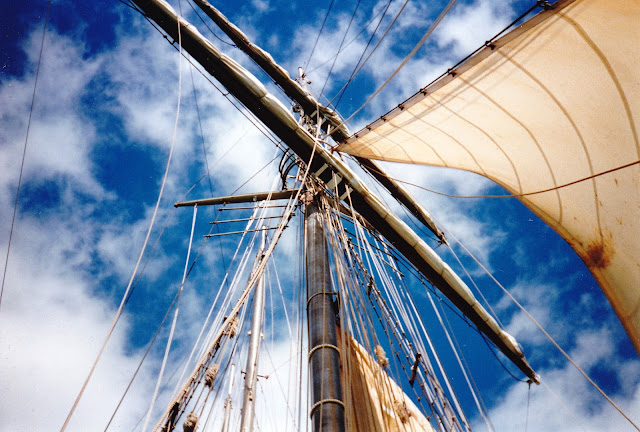Thursday, 20th March
It was all hands on deck after
breakfast to prepare the ship for leaving port. John and I from our Watch were
under the Boatswain’s (Pronounced ‘bosun’) charge to let go the mooring lines
from the quayside. The Boatswain is a senior member of the ship’s crew who is
responsible for the rigging, anchors, cables, sails, and other items that keep
a ship running smoothly. They are like a foreman of the ship's crew, as they
issue orders to the deck crew.
As we were left ashore from
letting go the moorings, we had to return to ship in the dinghy and climb up
the ladder aboard, just like something out of a good pirate film.
Mizzen Watch were duty Watch
again, and I was starboard lookout and had to keep watch with binoculars for
ships and buoys that were on our course. Technically motor ships should give
way to sail, but larger ships such as tankers have such large turning circles
that it may not be physically possible for them to change course to avoid us.
My job was very important as we were heading into some of the busiest shipping
lanes in the world, as we headed away from Weymouth and south, towards the
French coast.
The rest of the day was plain
sailing as the wind had dropped considerably from the strength of the previous
night – so much so that we even had to motor-sail part of the way. We spent our
second night at sea, this one much calmer than the first.
 |
Friday, 21st March
The following day brought another
day of plain sailing. The weather was glorious, no-one was sick, and despite
being only early Spring most people even got sunburned. As the weather was so
fine, the sun so bright, and all but one sail was set we launched the rubber
dubby (the ship’s dinghy) and a small party of designated photographers went
out with all of the crew’s cameras to take pictures of the ship in her
near-full glory.
 |
We did our watches as usual, Mizzen
had the second dog watch, from 1800hrs to 2000hrs. Most watches are four hours
long, and you would spend one watch period on standby, ready to be called or
woken in the event of an emergency, then start duty on the next watch, then
have your rest. With three Watches of crew rotating through six work watches in
24 hours, obviously everyone would always be stuck on the same timings each
day. Therefore one four-hour period is split into the two dog watches, meaning
there are 7 watches in total and the crew rotates onto different timings each
day.
 |
We had been up in the rigging
setting the square topsail before darkness arrived, and as we were descending
the ratlines we were treated to the most beautiful sunset. In the middle of the
channel, with no light pollution, the darkness also brought us not only a
brilliant array of stars, but also spectacular views of the twin tailed
Hale-Bopp’s comet which, although I didn’t know it at the time, was then very
nearly at its closest point to the Earth.
 |
We absorbed this spectacular view
and enjoyed the calmness for a while, but we didn’t linger too long as by this
point we had learned to sleep whenever the opportunity presented itself, so we
were all early to bed after watch.
No comments:
Post a Comment